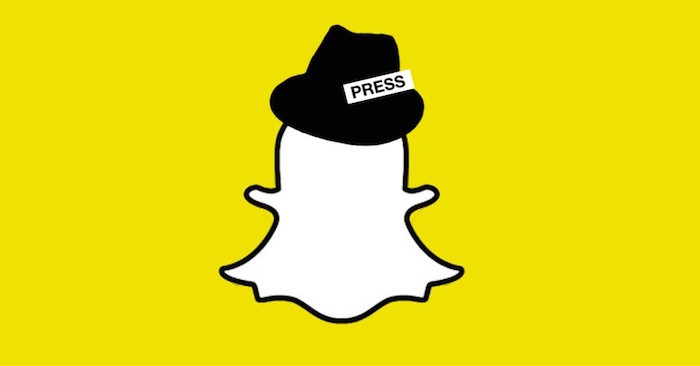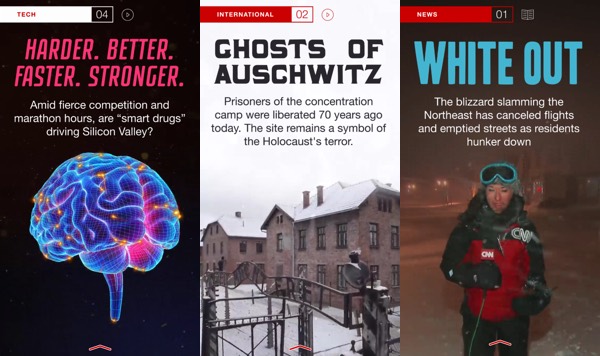
You may have missed it in the #snowpocalpyse that wasn’t1, but Snapchat unveiled a new feature called Discover Tuesday that puts news into the ephemeral chat app so popular among American teens and young adults:
I should confess here I am a 39-year-old man, which you can take as a pretty good indicator of my daily Snapchat usage (zero). But from playing around with Discover yesterday and today, it feels like a significant moment both for mobile news and for efforts to reach younger readers. We write a lot about how messaging and chat apps are a big area of growth for online life (and a big potential area of growth for online news). But that sometimes gets portrayed as something happening mostly outside the U.S. True, we don’t have anything as developed as, say, WeChat’s platform in China, and there may be less experimentation by news organizations on chat platforms here than elsewhere. But that doesn’t mean the shift in our audiences’ attention is any less real.At launch, Snapchat is working with ten media partners, including CNN, ESPN, and National Geographic. These companies will release a new edition of Discover content every 24 hours, featuring both videos and articles hand picked by their staffers. The goal for these media companies, of course, is to hook a new, younger audience that doesn’t often connect with traditional media.
What’s impressive about Snapchat Discover? Three things:
Snapchat’s UX remains a confusing mess to me — it feels a little like that tone only teenagers can hear — but there’s no denying a lot of young people spend a tremendous amount of time in the app.
If you buy the argument that the share of consumers that regularly, purposefully seeks out news for news’ sake is relatively small — that a large portion of the audience has always encountered news through a mix of adjacencies, social vectors, habits, and accidents — it makes sense that news will have to be integrated into how people are already interacting with the broader universe of information. Putting news just a couple taps away from someone’s social life has enormous potential power. The chances of low-interest-in-news people getting some headlines and stories that way seems higher than expecting them to suddenly build a habit of opening your app every morning.
This is the same logic for news organizations being on social networks like Twitter and Facebook: Go where the audience is. And unlike those platforms, Snapchat’s Discover lets advertising come along for the ride.
These are not newspaper stories or TV pieces stuffed awkwardly into new containers. The “Snap” formatting — framed vertically like your phone, constructed as a single view, intermixing audiovisual elements, swipes to move between them — echoes what people see in their friends’ messages. It’s completely and utterly mobile; there is no web-native equivalent, and there likely never will be. The updated-once-a-day model makes the news contained, something you can finish. Constructing these snaps probably takes some producer a little time (I don’t know what native tools Snapchat is providing them, if any), but the effort pays off. Here are a few from CNN; in app, the first features music and animation, the second video and music, the third video of a brief looping live shot. (You can also see some of the motion graphic work in the video below by Robb Montgomery.)

The advertising feels just as native to the platform — another snap to swipe through.
Each of those single-frame content teases can link to a bigger piece of content, which you access by swiping up. That content can be short or long, text or video. (The blizzard piece pictured leads to a story, the Auschwitz piece to a 1:46 video, the smart drugs piece to a 3:26 video.) Some are self-contained and don’t link to anything. The Daily Mail’s pieces link to classic Daily Mail-style long, scrolly, photo-laden stories. Yahoo News has Katie Couric voice all the teases. Vice’s section of the app includes multiple 15-minute-plus documentaries, on subject like the California drought and migrants trying to enter Europe. National Geographic has a quiz (though without any real interactivity — the answer’s just revealed by swiping up).
I’m calling this connection to a longer piece of content a “link,” but what you won’t see in here is a webview — the sort you’d see clicking a link on Twitter or Facebook and going to a publishers’ website. The content here all lives inside Snapchat. (Facebook’s dream for the web, basically. Or how Flipboard’s publishing partners appear differently in its apps.) There are obvious reasons why that could be bad news for publishers — loss of control, loss of flexibility in revenue models — but there are also obvious ways that a consistent experience across brands and stories could be appealing to users.
There are also obvious issues with the current iteration of Snapchat Discover. It’s limited to a small set of publisher partners, and it’s easy to imagine problems if and when it scales up — navigation problems, discovery problems, personalization problems. As theoretically flexible as the platform may be content-wise, putting news next to friends’ snaps would seem to encourage shorter stuff from most publishers. (Though I’d love to know how many of Vice’s longer pieces get viewed all the way through by Snapchat users.) The advertising model, while promising, is unproven — the swipe interface also makes it very easy to identify an ad and swipe it out of the way in less than a second. (Banners at least stick around while you read the story!)
But Snapchat is 100-percent worth watching for anyone involved in news — particularly those wondering how it’ll transition to phones. Last month, I wrote this piece that asked: “What will be the laid-back, low-effort experience that replaces TV news?” The Internet has been amazing for news junkies — there’s more available for us to seek out than ever before in human history. But it’s a different story for that larger group of low-effort news consumers, the ones who aren’t going to seek it out. The decline of newspapers and television news — both of which packaged civically useful news with a bunch of other stuff — has left them a little adrift, relying on what Facebook’s algorithms serve up or whatever else they can encounter via accidental osmosis.
I still don’t know what that laid-back, low-effort news experience is going to look like — but I can promise you it’ll involve content made for our phones, and Snapchat Discover feels like a step in that direction.
If you don’t believe me, ask some of Today’s Youth! John Robinson, the former editor of the Greensboro News & Record and now a lecturer at the University of North Carolina, is teaching a class on “Current Issues in Mass Communication” that asks its students to blog regularly about media. A number of them took up yesterday’s Snapchat announcement. While you shouldn’t extrapolate from these few college kids to all their demographic peers, it’s an interesting look at how some of Snapchat’s core users took to the feature.
Clay Sutton: “I just updated the app around 12:30 this afternoon, and I haven’t left it since. So far, I’ve watched an NFL season recap in 160 seconds, checked in on the wonderful weather in NYC, and went behind the scenes of a J.J. Watt/Katy Perry photo shoot. Discover seems to have something for everyone…Right now, I’m not even concerned with snapping my friends back. I’m too entertained by the fact I can get my Daily Show with Jon Stewart clips from the same place I can now watch ESPN’s Not Top 10.”
Liz Bell: “This is huge. Snapchat is adapting and showing that it’s here to stay — at least for a while. It’s not just a messaging app although it still feels personal and private (and something we can post to without our parents seeing). It gives perspectives to events — sports games, competitions, national holidays, wherever you wish you were — that you can’t get anywhere else. With Snapchat you are an insider and a contributor…Plus, it’s search engine/Facebook algorithm free. We see what they post. In the order they post it. This is different and matters. CNN’s head of social news Samantha Barry says she thinks this might be a huge step in finding how to reach millennials, hard news and all. I think she’s right.”
Emma vanBree: “It has definitely changed the game. Snapchat has the potential to be a real-time YouTube, and this app definitely capitalizes on that. It’s hard to say yet, but I think this update will really validate Snapchat as a media source and social media. I’m still amazed that they could fit all of this content into one app…Maybe having the news right here will help me to finally put some health in my media diet. But I do admit, I have only viewed the Cosmopolitan one, but here’s to hoping!”
Lauren Pershke: “To me, the introduction of Discover is a way to merge Snapchat into more of an intellectual news realm. While the majority of Snapchat’s users are under the age of 25, these users are growing up. As noted in class, there comes a time as a professional where sending selfies behind your desk is generally frowned upon and left up to the younger crowd (of this already young user base). By introducing news and entertainment sources, Snapchat is still proving itself useful to those who opt out of the selfies.”
Morgan Trachtman: “Discover will finally give Snapchat a way to make money as they will share ad revenue with their new media partners. I anticipate many more media channels knocking on their door hoping to gain a spot on the new feature…I think it’s the perfect way to get information to a younger generation that’s been too caught up in posting the perfect 10 second selfie than reading a newspaper.”
Amber Younger: “As for ads, I only ran into one. Much to my surprise I was able to slide it away immediately. Even if ads don’t become mandatory viewing in the near future, Discover’s layout paired with creative ad design could keep a user watching for a bit. The BMW ad I saw looked very much like another CNN story.”
Alexandra Arteaga: “Today I was able to watch a 5-minute National Geographic video about a couple in Panama that rescues sloths and release them back into the wild. Then I read ‘The Bachelor Recap’ post on People’s channel to catch up on everything I missed in last night’s episode. And then I read an CNN article on the Northeast’s ‘blizzard,’ which went along nicely with the “Snowpocalypse: Juno” OurStory. The fact that I was able to do all of this on one app speaks for itself.”